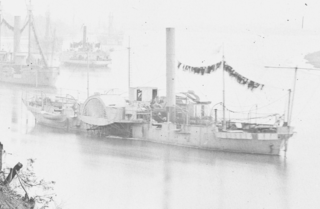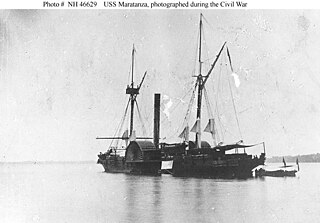
The first USS Miami was a side-wheel steamer, double-ender gunboat in the United States Navy during the American Civil War.

USS Southfield was a double-ended, sidewheel steam gunboat of the Union Navy during the American Civil War. She was sunk in action against the Confederate ironclad ram CSS Albemarle during the Battle of Plymouth (1864).

The first USS Sassacus, a wooden, double-ended, side-wheel steamer, was launched on 23 December 1862 by the Portsmouth Naval Shipyard in Kittery, Maine, sponsored by Miss Wilhelmina G. Lambert. Sassacus was commissioned at the Boston Navy Yard on 5 October 1863, Lieutenant Commander Francis A. Roe in command.

USS Stars and Stripes was a 407-ton steamer acquired by the U.S. Navy and put to use by the Union during the American Civil War.

The second USS Louisiana was a propeller-driven iron-hull steamer in the United States Navy during the American Civil War.

USS Albatross was a screw steamer rigged as a three-masted schooner acquired by the Union Navy during the beginning of the American Civil War. She was outfitted as a gunboat with heavy guns and used in the Union blockade of the waterways of the Confederate States of America.

The Battle of Elizabeth City of the American Civil War was fought in the immediate aftermath of the Battle of Roanoke Island. It took place on 10 February 1862, on the Pasquotank River near Elizabeth City, North Carolina. The participants were vessels of the U.S. Navy's North Atlantic Blockading Squadron, opposed by vessels of the Confederate Navy's Mosquito Fleet; the latter were supported by a shore-based battery of four guns at Cobb's Point, near the southeastern border of the town. The battle was a part of the campaign in North Carolina that was led by Major General Ambrose E. Burnside and known as the Burnside Expedition. The result was a Union victory, with Elizabeth City and its nearby waters in their possession, and the Confederate fleet captured, sunk, or dispersed.

USS Unadilla was a Unadilla-class gunboat built for service with the United States Navy during the American Civil War. She was the lead ship in her class.

USS Aries was an 820-ton iron screw steamer built at Sunderland, England, during 1861–1862, intended for employment as a blockade runner during the American Civil War. She was captured by Union Navy forces during the Union blockade of the Confederate States of America, and was commissioned as a Union gunboat. Aries was named for the constellation.

USS Maratanza was a steamer acquired by the Union Navy during the American Civil War. She was used by the Union Navy as a gunboat to patrol navigable waterways of the Confederacy to prevent the South from trading with other countries.

USS Young America was a Confederate steamer captured by the Union Navy’s blockade vessels, and subsequently placed in-service in the Union Navy during the American Civil War.
USS Whitehall was a steamer acquired by the Union Navy during the American Civil War. She was assigned blockade duty; however, her condition was not always considered seaworthy, and she was plagued with condition problems.
USS John L. Lockwood was a steamer acquired by the Union Navy during the American Civil War. She was needed by the Navy to be part of the fleet of ships to prevent blockade runners from entering ports in the Confederacy.

USS Underwriter was a 341-ton sidewheel steamer that was purchased for military use by the Union Navy during the American Civil War.
USS Shawsheen was a steam operated tugboat acquired by the Union Navy during the American Civil War.
USS Western World was a ship acquired by the Union Navy during the American Civil War. She was used by the Navy to patrol navigable waterways of the Confederacy to prevent the South from trading with other countries.

The first USS Uncas was a 192-ton steamer acquired by the Union Navy during the American Civil War.
USS Isaac N. Seymour, also referred to variously as Seymour, I. N. Seymour and J. N. Seymour, was a steamer acquired by the Union Navy for use as a gunboat during the American Civil War. She was used by the Navy as a littoral ship in fire support, supply and blockading roles.
USS Wyandotte, originally USS Western Port, was a steamer acquired by the Navy as a gunboat for the Paraguay expedition in 1858. When the crisis of the American Civil War occurred, she operated in support of the Union Navy blockade of Confederate waterways.
USS Henry Brinker was a small steamship acquired by the Union Navy during the American Civil War. She was placed into service as a gunboat and assigned to the blockade of ports of the Confederate States of America.















